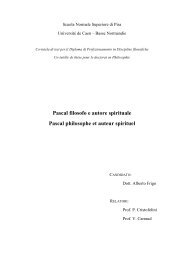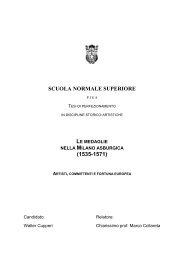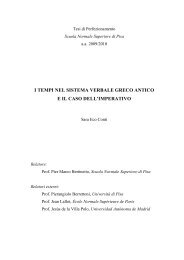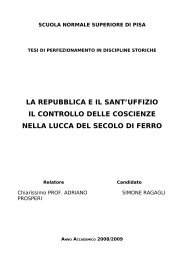CATULLUS 68 - Scuola Normale Superiore
CATULLUS 68 - Scuola Normale Superiore
CATULLUS 68 - Scuola Normale Superiore
Create successful ePaper yourself
Turn your PDF publications into a flip-book with our unique Google optimized e-Paper software.
All this makes it very hard to tell why exactly Cupid is wearing a saffron-coloured robe at this point. Is it an<br />
unconscious hint that Catullus wants to marry Lesbia? Or is the god wearing this exotic and luxurious<br />
garment simply to add glamour to this special occasion? In view of lines 135-148 (‘in fact Lesbia is not my<br />
wife, and she also has other lovers, but I will put up with it all’) the second possibility appears much more<br />
likely.<br />
in tunica is sometimes used to mean ‘wearing a tunic’, especially when accompanied by an adjective, which<br />
is not possible with tunicatus: compare Cic. Rab. Post. 27 in tunica pulla, Prop. 2.6.14 in tunica suspicor<br />
esse uirum, 2.29b.26 ostrina cum fuit in tunica and 4.2.38 demissis institor in tunicis. Similarly in toga (Cic.<br />
Phil. 1.18, Sen. 11 and Fam. 6.6.5, Vell. 2.29.3, Pliny N.H. 7.117, Quint. Inst. 2.16.8, Tac. Ann. 1.12, Mart.<br />
Epigr. 6.50.2, etc.), in armis (Cic. Sen. 11 nec uero in armis praestantior quam in toga) and so on: OLD s.v.<br />
in, 36a.<br />
candidus Cupid has a radiant white complexion. In the view of Clarke (2003: 58) his whiteness is a sign of<br />
his divine power, but it is surely a sign of his youthful looks, as only two male gods are ever called candidi,<br />
namely the youthful Cupid (here and at Prop. 2.3.24 candidus … Amor) and the effeminate Bacchus (Hor.<br />
Od. 1.18.11 candide Bassareu, Prop. 3.17.29 candida … colla, of Bacchus’ neck, and Lygdamus ap. [Tib.]<br />
3.6.1 Candide Liber, ades, and already at Eur. Ba. 457; see on line 70 above for the application of the term to<br />
a goddess). In fact, in the visual art of the late Republic and the Roman Empire whiteness is a special<br />
characteristic of Bacchus and Cupid (for illustrations see LIMC s.v. ‘Dionysos/Bacchus’ and ‘Eros/Amor,<br />
Cupido’). Bacchus’ fair skin is part of his characterization as an effeminate young man and can be attributed<br />
to his indoor, luxurious lifestyle; Cupid on the other hand is fair-skinned because he is a child, and perhaps<br />
also because just as Bacchus he is associated with a life of rest and of luxury (in fact, both gods are depicted<br />
as slightly overweight). This is exactly the life that Catullus aspires to here.<br />
135-148 “Lesbia is not satisfied with me alone, but I shall accept it, so as not to act like a boor; why, the<br />
queen of the gods also accepts the infidelities of her husband; and anyway, Lesbia is not my wife but that of<br />
somebody else; it is enough if she sees me on her most special days.” Catullus’ attempt to come to terms<br />
with the promiscuity of his beloved has caused incredulity among scholars, including Sarkissian (1983<br />
passim, e.g. p. 23). I for one have seen similar things happen, and believe that love can dull one’s common<br />
sense to a surprising degree.<br />
Catullus’ self-deception puts the language under strain: see on line 137.<br />
135 tamen etsi ‘Even though’. This conjunction is also found in Plautus (Most. 1167), Ennius (Ann. 560<br />
Skutsch), Pacuvius (trag. 46 and as a textual variant also in the epitaph that the poet supposedly wrote for<br />
himself: Epigr. Pac. 1 ap. Gel. 1.24.4, see FPL 3 p. 75), Terence (Andr. 864), Varro (De Sermone Latino frg.<br />
31 Semi ap. Annaeum Cornutum ap. Cassiodor. GL 7.154.2), Lucretius (3.1018) and Cicero (De Orat. 2.210<br />
and Att. 12.1.1 as well as 5.17.2, where one should surely divide nos (tamen etsi … rather than nos tamen<br />
(etsi … with the current editions). In the Augustan period tamen etsi disappears entirely from poetry, while in<br />
230






